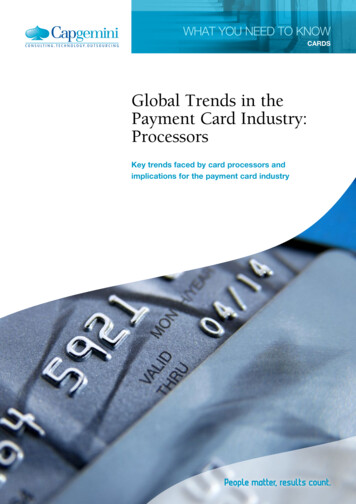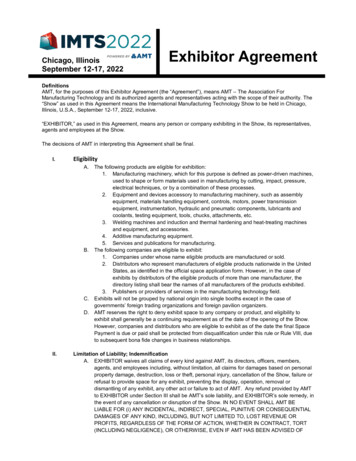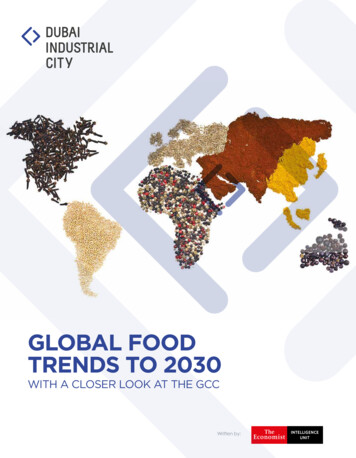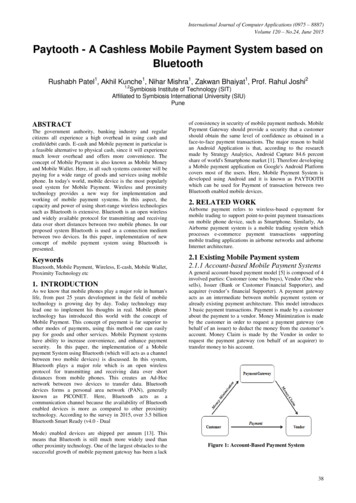
Transcription
What you need to knowCARDSGlobal Trends in thePayment Card Industry:ProcessorsKey trends faced by card processors andimplications for the payment card industry
Contents21. Highlights32. Introduction42.1. Global Payment Card Industry Performance42.2. Key Payment Card Industry Participants53. Emerging Trends in the Payment Card Industry: Processors74. Trend 1: Increased Focus on Consolidation of Processing Platformsand Processing Infrastructure across Geographies85. Trend 2: Increased Focus on Delivering Value-Added Services toMerchants and Banks116. Trend 3: Increased Focus on Fraud Detection and Prevention toMinimize Merchant Losses13References15
the way we see it1 HighlightsThe payment card industry was relatively resilient to the global economicslowdown, with cards transaction volumes up by 8.4% in 2009. The growth wasprimarily driven by stronger growth in the developing markets of Asia and LatinAmerica. Transaction volumes are expected to continue to grow in 2010 withdeveloping countries such as China and Brazil as growth engines. The averageglobal value of card purchases has been slowly declining as consumers in developednations cut down on their big ticket purchases.The key payment card industry stakeholders of card acquirers1, card processors2,and card issuers3 are all witnessing shifting trends. This paper identifies the keyemerging trends pertaining to the processing side of the payment card industry.The commoditized nature of the cards processing business has led to a wave ofconsolidation in the processing industry, with many larger players aggressivelylooking out for inorganic growth in order to achieve scale. Large-scale M&A activitycombined with increasing joint-venture alliances with banks has driven largerprocessors to consolidate their processing platforms and data processing centers.While size has traditionally been one of the biggest differentiators for processors,these firms are now looking to provide various value-added services to theircustomers and end-users in order to stay competitive. These value-added services(such as fraud management and business intelligence) are not only expected tohelp various card industry stakeholders, but also help processors to maintain theirprofit margins as it generally increases customer loyalty. Additionally, such add-onservices provide opportunities for processors to be value differentiators.The amount of losses that merchants incur on account of card frauds is a pressingconcern for the merchant community. For example, in 2010 alone US-basedmerchants are expected to have lost more than US 100 bn by way of card frauds.Processors can play an important role in reducing these fraud losses for merchantsthrough increased investments in fraud detection/prevention technologies andkeeping the merchants abreast about emerging fraud schemes and commonly usedbest practices to mitigate fraud risks.Acquirer refers to merchant’s bankProcessor refers to a third party organization that aids in card authorization and settlement process (sometimes acquirersperform this task themselves)3Issuer is the cardholder’s bank which issues a credit/debit/prepaid card and maintains the customers’ accounts4LexisNexis True Cost of Fraud Study, 201112Global Trends in the Payment Card Industry: Processors3
2 Introduction2.1. Global Payment Card Industry PerformanceThe global payment card industry was relatively resilient to the financial crisis of2008-09, as evidenced by the 8.4% growth in card transactions volume whichincreased to 132.1 billion transactions in 2009 (as compared to 122.0 billiontransactions in 2008 as shown in the exhibit below). Cards represent one of themost preferred non-cash payment instruments, with an estimated 40% of the globalnon-cash payments being routed through cards5.Developing nations in AsiaPacific and Latin Americaare increasingly replacingtheir cash transactions withdebit and credit cards, whichis driving the card industrygrowth in the region.Based on a regional comparison, Asia-Pacific has been one of the fastest growingregions in terms of card usage. Cards transaction volumes grew by 18.1% during2008-09 within Asia-Pacific, compared to North America and Europe which grew4.7% and 7.3% respectively for the same period.Exhibit 1: Global Card Transactions by Volume (bn), 2005-2009140122.0Transaction Volume 2.1%8.4%Latin America21.8%14.1%Asia Pacific21.4%18.1%Europe8.3%7.5%North 0520062007200830.167.420090Source: Capgemini Analysis, 2011; ECB; Red Book 2010; World Payments Report, Capgemini 201154World Payments Report, 2011 (Cards represent just debit and credit card transaction across the globe)
the way we see itIn 2008 and 2009, the payment card industry represented the two-speed nature ofglobal economic growth, with developed nations slowing down and the developingnations growing strongly. For instance, the transaction volume growth in developedcountries was modest, with the U.S. growing by 4.7% and the Eurozone growing by6.8%. This was slower than their historic 2005-08 compound annual growth ratesof 10.6% and 7.6% respectively. On the other hand, developing nations witnessedhigher card usage, with China growing by 32%, Russia by 30.9%, and Brazil by10.1% annually in 2009.This two-speed growth is expected to continue in the near-future. The still-lowabsolute usage levels of cards as a payment channel in developing nations, coupledwith the potential for faster economic growth, augurs well for the payment cardindustry in these regions. However, card industry growth measured by transactionvalue is expected to be subdued in the near future as weaker consumer confidencein most developed nations is likely to manifest itself through a lower amount of highvalue purchases as already witnessed in 2009 in the U.S. and peripheral Europe.The slow growth in transaction values, increasing regulations designed to favorand protect card users (in terms of fees charged), and competition from otherpayment sources is expected to put pressure on margins for payment card industryparticipants. Various stakeholders therefore need to better utilize technology to dealwith compliance issues, and stay ahead of the competition within the industry aswell as external competition such as mobile payments.2.2. Key Payment Card Industry ParticipantsA simple card transaction between a cardholder and a merchant involves severalplayers:Card acquirers: the merchant’s bank. Card processors: third party organization that aids in card authorization andsettlement process. Card issuers: the cardholder’s bank who issues the card and maintains thecustomers’ accounts. Global Trends in the Payment Card Industry: Processors5
Additionally, card association network providers (typically MasterCard or Visa )play an essential role in completing the card authorization and settlement cycle,as illustrated in the following exhibit.Exhibit 2: Typical Card Transaction Flow Structure1287Merchant StoreE.g. BestBuyBuyer10ProcessorE.g. FirstData9MerchantBank / AcquirerE.g. Citi65Issuing Bank / IssuerE.g. Bank of America43Card Association1Cardholder uses a credit card to pay for a purchase transaction2Merchant sends transaction information to the acquirer by swiping ormanually feeding card information at the POS terminal3The acquirer or third-party processor on acquirer’s behalf sends thetransaction information to the card association4The card association sends the transaction information to the issuerfor authorization5Issuing bank pays the card association network once it validates thetransaction (after deducting their charge)6Card association pays the acquirer processors on acquirer’s behalf(after deducting their charge)7Merchants account is credited for the transaction amount by theprocessor (after deducting their charge)8Purchase transaction is completed9Issuer bills the buyer for the transaction based on the billing cycle10 Buyer settles the billSource: Capgemini Analysis, 2011, “Transaction Flow”, Serve First Solutions, Inc., y/42-transaction-flowThis paper focuses on the key trends that the card processors have beenexperiencing and how the industry is responding.6
the way we see it3Emerging Trends in thePayment Card Industry:ProcessorsCard processors are third-party non-banking firms who offer basic paymentprocessing services although some large banks conduct payment processingservices in-house. These processing firms play a vital role in a typical cardpayment transaction.The emergence of third party processors (TPPs or processors) in the card paymentecosystem over the years can be linked to two technological developmentswhich have made outsourcing these operations a viable and cost efficient option:Globalization of banks leading to evolving acquirer/issuer requirements, andchanging merchant and customer expectations.The primary activity of TPPs is payment processing, which involves atwo-step process:1. Authorization – Flow of customer information from the merchant to the issuercarried out to check the authenticity of the card presented. This process starts themoment the merchant swipes the customer’s card at the point of sale terminal.2. Clearing & Settlement – Flow of funds from the issuer to the merchant aftereach card industry stakeholder (issuer, acquirer, card network and processor)take their cut. This process starts the moment the issuer authorizes a cardswipe transaction.Apart from payment processing services, the TPPs play a crucial role in supportingthe acquiring side of a card transaction with certain ancillary services. These ancillaryservices include acquiring new merchants, providing fraud protection servicesservices, and providing training and other terminal operation support activities tothe merchants. TPPs sometimes also have to bear certain portion of fraud liabilityof card transactions as a cover for the fraud protection services that they offer to themerchants. On the issuing side, TPPs offer a wide array of transaction processingservices from application handling to arrear management.The card processing industry has seen massive consolidation over the years drivenby the commoditized nature of core payment processing and firms’ drive to achieveeconomies of scale. The industry consolidation, coupled with need to differentiateby offering value added services including fraud protection, has led to three majortrends for the card processors:1. Increased focus on consolidation of processing platforms and processinginfrastructure across geographies.2. Increased focus on delivering value-added services to merchants and banks.3. Increased focus on fraud detection and prevention to minimize merchant losses.Global Trends in the Payment Card Industry: Processors7
4Trend 1: Increased Focus onConsolidation of ProcessingPlatforms and ProcessingInfrastructure across Geographies4.1. Background and Key DriversThe third-party card processing industry has seen massive consolidation overthe past decade due to the commoditized nature of their core operation - cardprocessing services. With little differentiation in the service offerings between anytwo different processors, they have primarily resorted to inorganic growth strategiesto achieve economies of scale through higher transaction volumes and a reducedaverage fixed cost per transaction.For most large processors, the wave of consolidation in the industry has necessitatedthe consolidation of various processing platforms and multiple data processingcenters. The key drivers for the consolidation of processing platforms and dataprocessing centers are:Large banks have either outsourced or disposed off their non-core acquiringbusinesses to card processors. The increased cost sensitivity of large issuers and acquirers has squeezed marginsfor card processors. Card processors are targeting improved profitability by building greater scale anddecreasing the cost of operations. The Single Euro PaymentsArea (SEPA) in Europe isalso triggering a wave ofconsolidation in the processingindustry in the region.4.2. AnalysisThe cards processing industry has witnessed aggressive inorganic growth by theindustry leaders to increase their scale of operations and geographic reach. Someof the recent acquisitions by major players in the processing industry include FIS’sacquisition of Metavante in 2009, and Global Payments acquisition of ZAO UnitedCard Services to gain access to the Russian market. Additionally, there have beensome notable joint ventures between processors and the acquirers such as FirstData’s alliance with Bank of America to provide payments solutions to its globalcustomers and the alliance between Global Payments and HSBC to offer merchantprocessing services.The Single Euro Payments Area (SEPA) is intended to create a common electronicpayment system for the entire eurozone area. SEPA has also triggered a wave ofconsolidation in the processing industry in the region.8
the way we see itWhile the growing amount of consolidation in the industry is bringing scalebenefits to the larger processors, smaller players lack the required scale and arefacing operational challenges due to increased margin pressure and their inabilityto compete with the larger players on lower pricing. Even larger players who havebeen growing their business volumes through inorganic growth are yet to enjoy thefull benefits of increased scale, since most of them still use non-integrated legacyplatforms. In order to achieve the full benefits from past consolidation, processorsneed to find a way to integrate multiple platforms.Exhibit 3: Card Authorization Cycle across ocessorSource: Capgemini Analysis, 2011Additionally, acquirers and issuers need payment systems which can perform thefour basic functions of a card processing cycle: Acquiring, authentication, switching,and authorization of their routine day-to-day card transactions.Global Trends in the Payment Card Industry: Processors9
A payment services hub can deliver these common services from a singleprocessing system. Currently most banks and card processors deploy multiplesystems for different product lines and geographies. Duplicity of functions increasescomplexity and reduces transparency of process, while adding to operational costs.In one example of a firm seeking to implement a common hub, leading processorFirst Data is on the path to consolidate its 12 data centers across the U.S. into threedata centers6.4.3. ImplicationsA successful consolidation of processing platforms can enable card processors totruly unlock the potential of scale and bring down cost of operations dramatically.However when compared to consolidating data centers, platform consolidation isa relatively tougher task as it needs the acquirer/processor to change systems at themerchant’s end.The SEPA directive in the eurozone area provides a unique opportunity forprocessors across eurozone to offer services at significantly lower costs, byconsolidating systems across countries.610First Data Cuts Data Centers as its Road Show Starts, September 2007 story/1511
the way we see it5Trend 2: Increased Focus onDelivering Value-Added Servicesto Merchants and Banks5.1. Background and Key DriversThe payment processing industry is consolidating through mergers and acquisitions.Processors are also entering into strategic revenue sharing alliances with largebanks. Over the years, transaction volume growth has been the key to successfor most large processors across the globe due to the commoditization of theirservice offerings. While size and presence across geographies still remain significantdifferentiators for an issuer or an acquirer to chose a particular processor, valueadded serivces provided by them are increasingly being looked upon as valuedifferentiators by the market.It is indeed imperative for processors to offer various value-added services such asbusiness intelligence support to banks, fraud and risk management services, anddispute management in case of chargebacks. These value differentiators help firmsto stay ahead of the competition, especially amidst the increasing commoditizationof the payment processing business which is reducing their pricing power.Card processors play an important role in the payment card industry and have thecapability to impact every stakeholder of the cards payment ecosystem-from thecustomer and merchant through financial services institutions, both issuers andacquirers. Every minor service offered that results in increased customer trust (fraudsecurity), increased merchant satisfaction (faster transaction processing), and growthin accounts for the issuers and acquirers can be considered as value-added.The key drivers for increased focus on value-added services by processors are:Transaction processing has become a commoditized business, with processorsfocused on growing volume to gain economies of scale. There is an increased demand for value-added services such as fraud management,customer data management, and analytics from the customers. 5.2. AnalysisProcessors offering value-added services, in addition to focusing plain vanillapayment processing, is not a new phenomenon in the payment card industry.However, the breadth of service offerings by processors is gradually increasing withprocessors sharing greater responsibilities from both the acquiring as well as theissuing side of business. While these services stand to benefit various stakeholders,they also help processors to maintain their profit margins in the increasinglycommoditized processing business.Global Trends in the Payment Card Industry: Processors11
Exhibit 4: Processors Gain from Investing in Value-Added ServicesCertain value-added servicesoffered by processors, suchas fraud management, aremore necessary in the currentindustry environment.Processor buildsinnovative valueadded servicesValue to Issuers: Drive transactiongrowth Lower churnValue to Acquirers: Greater pricing powerwith large merchantsValue to End Users Customers attracted toproposition and remain‘sticky’ because of: Convenience Reduced losses due tofraud mitigation Trust Improved relationship withcardholders Increase in valuefor money per eachtransaction Better service due todifferentiationThreats to processorprofitability from: Growing consolidationin industry Increased commoditization Cost driven decision makingof banks and merchantsImprove profitabilitythrough greaterpricing powerSource: Capgemini Analysis, 2011Processors can help various stakeholders by leveraging the enormous amount ofvaluable customer information that they have in their possession in their day to daypayment processing business. In order to maximize the value from each cardholderand increase customer retention, issuers need the ability to migrate customersbetween products based on customers’ changing needs. In these cases, processorscan help issuers by tracking customer usage and providing them with importantinputs on how they can enhance their value proposition to customers.Overall, processors are expected to show greater value per transaction to supporta higher price for their service offerings, as merchants challenge charges leviedby processors.5.3. ImplicationsCard processors have to focus on building value-added services that arerelevant to their customers in order to differentiate themselves and avoidbecoming commoditized.Analytics services, such as tracking card usage and providing business intelligenceservices to issuers, serve the best interest of the entire card industry ecosystem,from firms to cardholders.12
the way we see it6Trend 3: Increased Focuson Fraud Detection andPrevention to MinimizeMerchant Losses6.1. Background and Key DriversIn their day-to-day business activity, processors are facing growing challenges whileprotecting merchants from different card frauds due to the increasing sophisticationof fraudsters. Processors play a crucial role in helping merchants from fraudmitigation, by way of educating them about handling various fraud risks andkeeping them informed about evolving fraud methodologies. Merchants feel thatbeyond education and information, they need to be up-to-date about the industrybest standards and best practices followed when it comes to tackling fraud7.In general, merchants shoulder the majority of the fraud burden in the case ofa friendly fraud8 or a fraudulent request for a refund, making it imperative forprocessors to focus on providing better fraud protection services to merchantorganizations. Merchants also have to face a significant fraud burden in all card-notpresent transactions involving credit card usage over the phone, mail, or internet.The key drivers for the increased focus on fraud protection services include:Merchants are often ill-equipped to control identify fraud, while security standardsput in place by PCI SSC have not helped much to mitigate fraud. Ease of card data duplication in traditional card formats exposes merchants tofraud. Chargebacks and interest charged on chargebacks are significant drivers of costwhich is generally borne by merchants. 6.2. AnalysisThe amount of losses that merchants incur due to card fraud still remains large,with U.S.-based merchants reporting losses of more than US 100 bn in 2010.While the number of fraudulent transactions has come down in 2010, the averagevalue of fraud transactions is seeing an upswing.Approximately 4% of around 24.6 million small business merchants (less thanUS 1 million in annual sales) operational in the U.S. are being victims of someform of a fraud or the other9. While these small retailers place high importanceon the security of customer information and avoiding card breaches, theirunderstanding about available fraud prevention tools and measures to secure datacan be insufficient. To bolster this expertise, continuing merchant education on cardsecurity issues, especially from processors, will be vital.789LexisNexis True Cost of Fraud Study, 2011Chargeback by a customer after making a genuine online purchase“Small Business Data Security Study, 2010”, First Data & National Retail FederationGlobal Trends in the Payment Card Industry: Processors13
Processors can help the merchant community through a greater focus on frauddetection and prevention technologies, as well as ensuring that merchants arekept abreast about emerging fraud techniques and the best practices that areused to mitigate fraud risks. Processors are adopting advanced risk mitigationtools specifically designed for online sales channels such as IP geolocation10 andtransaction verification services.11 Moreover, online purchases are being subjected toadditional authentication through Verified by Visa and MasterCard SecureCode in order to further reduce fraud risk for online merchants.6.3. ImplicationsCard processors need to respond to the growing demand for fraud detectionand prevention services from merchants and financial institutions in order toremain competitive.Processors need to invest in training the merchant community about the evolvingcard fraud techniques to minimize fraud risks. Furthermore, investments also needto be made by processors in making card-not-present transactions more secure bypromoting certain proven technologies such as transaction verification within themerchant community.101114IP geolocation enables users to identify geographical location of an IP addressTransaction verification validates customer identity such as residence/billing address
the way we see itReferences1. World Payments Report 2011, Capgemini2. First Data Cuts Data Centers as its Road Show Starts, Digital dex.php/news/story/1511,September 18th, 20073. “Transaction Flow” Serve First Solutions, y/42-transaction-flow, accessed on 28th September 20114. True Cost of Fraud Study, LexisNexis, 20095. True Cost of Fraud Study, LexisNexis, 20116. “The life of a Visa transaction”, Visa Inc, http://usa.visa.com/merchants/newacceptance/how it works.html#anchor 3, accessed on October 12th, 20117. “MasterCard Rules”, Master Card, e Manual public.pdf, July 15th, 20118. “First Data Streamlines to Seize Debit-Rule Chance”,American Banker, January 13th, 20119. “Small Business Data Security Study, 2010”, First Data &National Retail FederationGlobal Trends in the Payment Card Industry: Processors15
What you need to knowCARDSThe What You Need to Know series fromCapgemini Financial Services is written by ourStrategic Analysis Group and provides trends,research, and analysis on key topics for financialservices firms.About the AuthorSantosh Ejanthkar is a Lead Consultant in Capgemini’s StrategicAnalysis Group within the Global Financial Services MarketIntelligence team. He has over seven years of experience in researchand strategy consulting for investment banking, asset management,private banking, and wealth management businesses.The author would like to thank Prasanth Perumparambil,William Sullivan, and David Wilson for their contributionsto this publication.For more information, visit www.capgemini.com/cardsor e-mail cards@capgemini.com.All products or company names mentioned in this document aretrademarks or registered trademarks of their respective owners.About Capgemini and theCollaborative Business ExperiencePresent in 40 countries, Capgemini reportedCapgemini, one of the2010 globalworld’sforemostprovidersAbout Capgemini andthe revenues of EUR 8.7 billion andof consulting, technology and outsourcing employs around 112,000 people worldwide.Collaborative Business Experienceservices, enables its clients to transformCapgemini’s Global Financial Servicesand perform through technologies.Businessbrings deepindustryreportedPresentinUnit40 countries,CapgeminiCapgemini, one of theexperience,innovativeserviceofferingsCapgemini providesitsclientswith2010 global revenues of EUR 8.7billion andandworld’s foremost providersnext generationglobal deliveryserve theand capabilitiestheiremploysaround nologythatand boostoutsourcingfinancial services industry.freedomenablesto achievesuperiorservices,its clientsto resultstransformCapgemini’s Global Financial Servicesthroughauniquewayofworking,theand perform through technologies.With a networkof 21,000professionalsBusinessUnit bringsdeep industryCollaborative Business Experience .servingover900clientsworldwide,experience, innovative service offerings andCapgemini provides its clients withCapgeminicollaborateswith leadingbanks,nextgenerationglobal deliveryto servetheThe Groupon its thatglobaldeliveryinsightsand reliescapabilitiesboosttheirinsurers servicesand capitalmarket companies to ofreedom to achieve superior resultsdeliver business and IT solutions and thoughtget the rightbalancebest talentthrougha uniquewayofoftheworking,theWitha networkof lue. from multipleBusinesslocations,working as. oneCollaborativeExperienceserving over 900 clients worldwide,team to create and deliver the optimumFor more informationvisit banks,Capgeminicollaborates pleasewith leadingTheGroupon its global stomodel called Rightshore , which aims todeliverbusinessandITsolutionsandthoughtget the right balance of the best talentleadership which create tangible value.from multiple locations, working as oneCopyright 2012rights reserved.team to createandCapgemini.deliver the AlloptimumFor more information please visitsolution for ht 2012 Capgemini. All rights reserved.What You Need to Know: Cards looks atemerging trends witnessed by three majorparticipants of the payment card industry:merchant acquirers, card processors, andCard Issuers. The papers include informationon the current situation, drivers, analysis, andimplications. The latest publications in this seriesare available at www.capgemini.com/cards.
The key payment card industry stakeholders of card acquirers1, card processors2, and card issuers3 are all witnessing shifting trends. This paper identifies the key emerging trends pertaining to the processing side of the payment card industry. The commoditized nature of the cards processing business has led to a wave of










